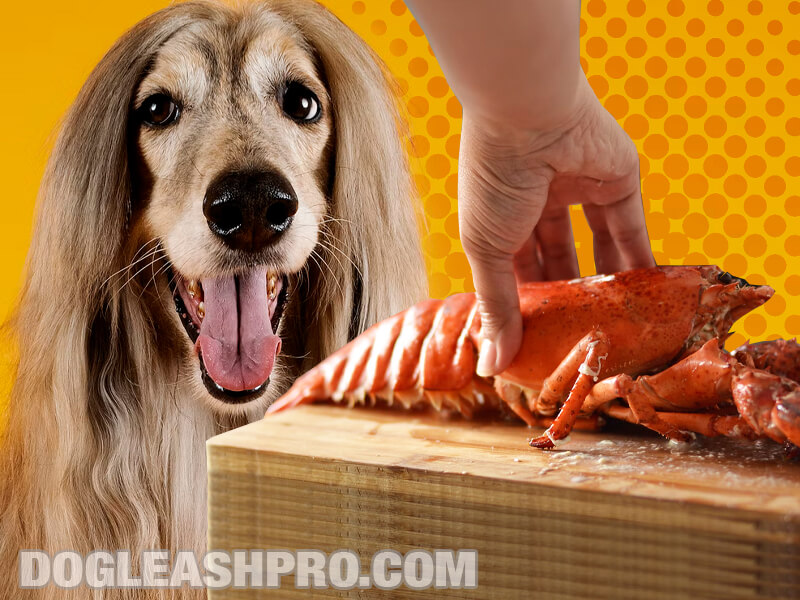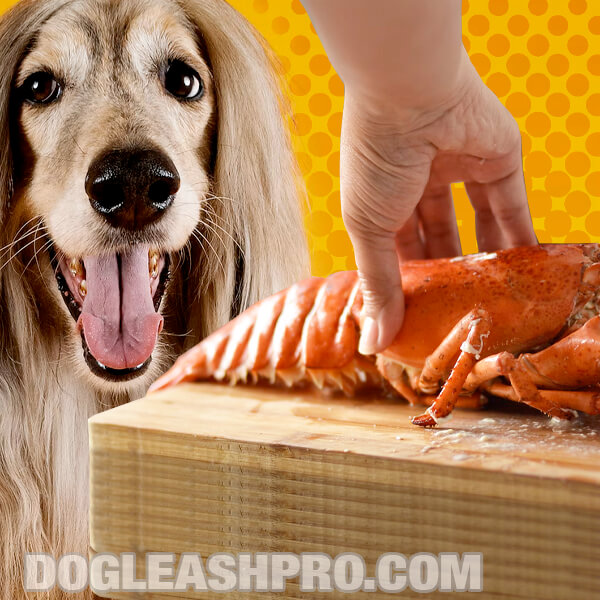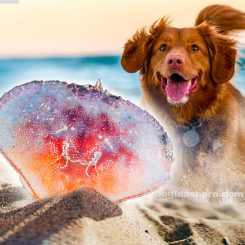
As I was enjoying some Lobsters yesterday, my two dogs sat patiently next to me and were eyeing me to offer them some. Having never fed my dogs Lobster before, I wondered, “can my dog eat Lobster?” Here’s the brief answer first before sharing this delicious seafood with your dogs.
Can dogs eat Lobster? Yes, dogs can eat cooked plain Lobster in moderation since it is packed full of essential minerals and a great source of protein. Before feeding your dog some Lobster meat, you’ll want to properly prepare it since raw Lobster can cause health issues and the Lobster shells can be a choking hazard. Be sure the cooked Lobster meat is plain and doesn’t have any added salt or seasoning.
In this guide, we’ll discuss everything you need to know about dog and Lobster, including how to properly prepare this seafood before feeding it to your canine friends and the health benefits cooked Lobster can provide to dogs. Let’s get started!
Table of Contents
Can dogs have Lobster?

Yes, dogs can have cooked Lobster meat in moderation. Our four-legged friends are devoted carnivores and they will undoubtedly love meat of all shapes, sizes, colors, and tastes.
Before feeding this tasty and nutritious seafood to your canine friends, you’ll want to cook it first. Cooked Lobster meat is quite delicious and succulent with its rich flavor and sweet meaty taste.
To properly cook the Lobster for your K9 friends, you’ll want to do the following:
- Using the largest pot, you’ll want to fill half the pot with fresh water and add salt. We use 150 grams of salt to 4.5 liters of water.
- Bring the pot of water to a boil.
- Drop your Lobster in (do not remove the bands on its claws) and cover the lid, then bring it back to a boil again. This should only take a few minutes.
- Once the water is boiling again, you’ll want to start the timer.
- The rule of thumb is to boil the Lobster for up to 15 minutes if it is 1.5 pounds. If the Lobster is over 1.5 pounds, you’ll want to add 5 minutes for each pound over that.
- After 15 minutes, you’ll want to pour out the water and gently wash the Lobster with fresh water. This will remove the white surplus protein.
- Allow the Lobster to cool down for at least 5 to 7 minutes.
- Remove the claws, crack them with a nutcracker, and remove the white Lobster meat.
- Next, pull off the Lobster’s tail and peel like a shrimp.
- Using a knife, cut the body in half (lengthwise).
- Remove the grey feathery gills and extract the Lobster meat.
As you can see, our furry friends should only have cooked Lobster meat.
Now, let’s discuss how feeding a moderate amount of Lobster meat can be beneficial for dogs.
Is Lobster good for dogs?

Yes, cooked Lobster meat is good for dogs in moderation. In fact, cooked Lobster meat contains essential minerals like magnesium, phosphorus, and zinc. It is also a wonderful source of protein and omega-3 fatty acids.
Here’s how these nutrients help benefit your K9 friends:
Lobster meat provides protein to maintain strong and healthy muscles in dogs
Dogs need protein because it allows their bodies to function properly. That’s because protein contains essential amino acids that help build and maintain healthy muscles, ligaments, tendons, cartilage, skin, nails, and hair in dogs.
Also, protein aid in making enzymes, antibodies, and hormones in dogs.
With sufficient protein intake, your furry friends will have a strong immune system as well.
So it’s a good idea to share some of that plain Lobster meat with your canine friends. Their strong bodies will thank you!
However, it is important to note that senior dogs and dogs with existing kidney failure or disease should avoid high amounts of protein intake since too much protein intake can be dangerous to them.
In fact, a diet that is too rich in protein can actually damage your pup’s kidneys. That’s because too much protein intake can increase the urea and this can put stress on the kidneys, thereby causing them to work much harder than usual.
It’s a good idea to provide your pooch with a well-balanced diet with sufficient protein intake. Too much protein intake can cause hyperkalemia, which is when there are high levels of potassium in your dog’s blood.
Lobster meat provides Omega-3 fatty acids which boost all aspects of your dog’s health
Omega-3 fatty acids help dogs both young and old. The DHA in omega-3 fatty acids aid in the proper eye and brain development in puppies. Omega-3 fatty acids can help older or senior dogs as well by improving their cognitive function and treating chronic kidney disease and canine arthritis.
Additionally, omega-3 fatty acids can help your K9 pals with the following:
- Reduce inflammation.
- Improve and strengthen your dog’s immune system.
- Promote a healthy heart.
- Fight cancer.
So go ahead and share a little bit of that cooked Lobster meat with your four-legged friends whether they are puppies or older senior dogs.
Zinc from Lobster meat helps promote healthy and strong joints in dogs
Our canine friends need zinc because this essential mineral helps to support your dog’s immune system and metabolism, promotes proper thyroid function, contribute to having strong and healthy joints, and aid in a healthy coat and skin. Zinc also plays a key role in wound healing as well.
If your pooch wants to try a new protein option, try feeding them a moderate amount of plainly cooked Lobster meat and see if they like it.
You may also like: Can Dogs Eat Crab Shells?
Phosphorus from Lobster meat provides dogs with healthy and strong bones and teeth
Phosphorus is another essential mineral that dogs need in order to have healthy metabolism, teeth, and bones.
Also known as dicalcium phosphate, phosphorus is often combined with calcium in the dog’s body to help build healthy and strong bone structure, achieve homeostasis, maintain cell structures, and assist in cell energy production.
Your dog’s body stores most of the phosphorus in their bones and only a small percentage of phosphorus is found in their blood.
Feel free to add a little bit of cooked Lobster meat to your dog’s diet. They will enjoy this sweet yet nutritious meat.
Lobster meat provides magnesium which helps dogs absorb vitamins and minerals
At the cellular level, magnesium helps your dog with energy production. Your pup’s heartbeat, muscle movement, and brain activity are all made possible thanks to the help of magnesium.
That’s because magnesium helps to facilitate the transfer of energy that allows your dog to play, eat, think, and even sleep.
Three other essential minerals in your dog’s body also rely on the role of magnesium. They are calcium, potassium, and sodium. When all four of these essential minerals are present in your dog’s body, your pooch can expect proper muscle movement, heart function, and nervous system signaling.
If your dog has magnesium deficiency (insufficient amount of magnesium present in their body), it can cause the other three minerals to drop as well.
Signs and symptoms of magnesium deficiency (hypomagnesemia) include:
- Muscle tremors.
- Muscle weakness.
- Muscle pain.
- Heart arrhythmia.
- Hyperactive.
- Walking difficulty.
- Abnormal or strange behavior.
- Lethargy.
By giving your K9 pals a little bit of cooked Lobster meat, you’re making sure that their bodies have a sufficient amount of magnesium.
Fun Fact: Bugs are a wonderful source of protein and some dogs love to play with Bugs and munch on them. But are they safe for doggy consumption? Check out Can Dogs Eat Bugs? to find out!
Is Lobster bad for dogs?
Yes, Lobster can be bad for dogs. Here’s how Lobster can be bad for your furry family members.
1. Lobster shells are hard and difficult for dogs to chew
If you leave the Lobster shells on, it can be hard for your dogs to chew and digest. When dogs keep chewing the Lobster shell, they can fracture and splinter their teeth, tongue, mouth, and throat.
Once digested, the sharp edges of the Lobster shells can also cause tears to your dog’s stomach and this can lead to internal bleeding.
2. Lobster shells can be a choking hazard for dogs
Lobster shells can also be hard to swallow and in fact, they can be a choking hazard. The Lobster shells can also cause suffocation if they’re not removed before consumption.
For these two reasons, it’s best that dog owners remove the Lobster shells and only feed their fur babies the Lobster meat.
3. Raw Lobster contains intestinal parasites
Another way a Lobster can be bad for dogs is if it is raw or uncooked. Depending on where the Lobster came from and where it was bred, it may carry intestinal parasites.
Thus, it’s always best to cook the Lobster first and only feed your pooch the cooked Lobster meat.
RELATED: White Specks in Dog Poop (Not Moving) – What Should You Do?
4. Dogs may be allergic to Lobster
Before you feed some Lobster meat to your canine family members, you’ll want to make sure that they are not allergic to the Lobster meat. Dogs can get seafood allergies just like us.
If you’re not sure whether your furry friends have seafood allergies, we highly recommend that your contact your vet to find out. Your dog’s vet will perform a thorough checkup and tests to find out if your pooch is allergic to Lobster.
Dogs that are allergic to Lobster or other seafood may experience the following symptoms:
- Loose and bloody diarrhea.
- Frequent vomiting.
- Upset stomach.
- Stress.
- Fever.
Food allergy is one of the most common allergies in dogs and if you suspect your pooch has a seafood allergy, consult your vet right away as this is serious and requires immediate medical attention.
5. Lobster meat contains high sodium content which is harmful to dogs
Did you know that about 5% of the Lobster is simply pure salt? While it may not seem a lot to us, this is a lot of sodium for our furry friend. While dogs need sodium, too much sodium is bad and can be harmful to our pups.
When dogs consume food, like Lobster meat, that is high in salt, they may start to experience the following symptoms of sodium poisoning:
- Swollen tongue.
- Headache.
- Nausea.
- Vomiting.
- Frequent urination due to extreme thirst.
- Loss of appetite.
- High blood pressure.
- Convulsions.
- Confusion.
- Walking around like they’re drunk.
- Fever.
- Fluid buildup in the body.
- Muscle spasms.
- Osteoporosis or loss of bone mass.
- Tachycardia or increased heart rate.
- Lethargy and lack of energy.
- Loose and watery diarrhea.
- Difficulty breathing.
- Upset stomach.
- Coma (in severe cases).
- Seizures (in severe cases).
If you suspect your canine family members have sodium poisoning, be sure to call your vet right away or contact the Pet Poison Helpline. Salt poisoning requires immediate medical attention.
Again, if your fur babies have heart issues, kidney failure, or have had a previous stroke, be mindful with how much Lobster meat you’re feeding them since high blood pressure from too much salt consumption can put them at a higher risk.
Is Lobster ok for dogs?
Yes, Lobster is ok for dogs if it is prepared properly before doggy consumption. This means cooking the Lobster until it is no longer raw and removing all the shells from the Lobster.
Proper preparation will ensure that your dogs aren’t consuming Lobster meat with intestinal parasites and they won’t choke from the hard and difficult-to-chew Lobster shell.
Dog and Lobster
Can dogs eat Lobster shell?
No, dogs should not eat Lobster shells. Be sure to remove the Lobster shells first and only feed your pooch the soft and fully cooked Lobster meat. Lobster shells are hard and difficult for dogs to chew. The Lobster shell can put a lot of stress on the dog’s teeth.
Additionally, dogs that keep chewing the Lobster shell can cause it to have sharp edges. These sharp edges can cause internal damage and bleeding to the throat and esophagus.
If the Lobster shell stays in the throat, it can be a choking hazard which can lead to suffocation in severe cases.
If your pooch does manage to swallow the Lobster shell, the sharp edges of the Lobster shell can tear the stomach and digestive system and cause internal bleeding.
Since the Lobster shell is difficult for the dog to digest, it can also cause intestinal blockage or bowel obstruction. In the worst-case scenario, intestinal blockage and bowel obstruction may require surgery. This surgery may put a big dent in your wallet, especially if this was unexpected.
Can dogs eat imitation Lobster?
No, dogs should not eat imitation Lobster. It’s important to note that imitation Lobster is exactly what it sounds like, imitation or fake Lobster. Since imitation Lobster is not real Lobster meat, dogs should avoid it.
That’s because imitation Lobster is mostly made of processed white fish and other additives and preservatives that are not healthy or safe for doggy consumption.
There is a lot of sodium, additives, added sugar, and binders in imitation Lobster which makes it unsafe for our dogs. In fact, if your pooch accidentally ate a lot of it, they may throw up or experience upset stomach or gastrointestinal distress.
With that said, it really depends where you buy your imitation Lobster. Some retailers boost that their imitation Lobster is the result of combining real natural Lobster meat with other ingredients like Wild Alaska Pollock, starch, salt, and eggs.
Before you feed imitation Lobster to your pooch, make sure to check the ingredients first.
You may be interested in: Can Dogs Eat Scallops?
Can dogs eat Lobster roe?
No, dogs should not eat Lobster roe. That’s because Lobster roe, which are the unfertilized eggs found inside both male and female Lobster, contain high levels of cholesterol.
High levels of cholesterol in dogs are also known as hyperlipidemia. When dogs consume a large amount of cholesterol, they start to have an excessive amount of fats in their blood. This can lead to obesity and even pancreatitis.
Dogs with a high level of cholesterol may experience symptoms such as abdominal pain, seizures, and patches on the skin.
Since Lobster roe does contain vitamin B, if you plan on feeding your pooch some Lobster roe, be sure it is in small amounts and in moderation. Do not give this to your dog every day or regularly.
Can dogs eat Lobster tails?
Yes, dogs can eat the meat of the Lobster tails in moderation since it is an excellent source of protein, omega-3 fatty acids, omega-6 fatty acids, and minerals like magnesium, phosphorus, and zinc.
However, moderation is key because consuming too much Lobster tail meat can lead to excessive cholesterol intake and can cause dogs to have constipation, diarrhea, loss of appetite, and even vomiting.
My dog ate a Lobster tail shell! What should I do?
If your dog ate a Lobster tail shell, you’ll want to observe and monitor him for up to 12 to 24 hours. You’ll want to contact your vet if you notice any changes in behavior or if your pooch is experiencing pain.
Your dog’s veterinarian may ask you to bring your pooch in for a physical and thorough check-up to make sure the Lobster tail shell didn’t cause any internal tear and bleeding or intestinal blockage and bowel obstruction.
Some vets may even recommend that you do not feed your pooch for up to 12 hours. After, you may want to feed him plain rice with chicken or simply chicken soup.
Can dogs eat cooked Lobster?
Yes, dogs can eat cooked Lobster since cooked Lobster meat is full of protein and contain essential minerals that dogs need. Be sure to only offer a small amount of cooked Lobster meat and remove all Lobster shells first.
Can dogs eat Lobster bisque?
No, dogs should not eat Lobster bisque because of the ingredients used to make this creamy and smooth soup. Lobster bisque is delicious and tasty due to its use of butter and spices like garlic, onion, and cayenne pepper.
Both garlic and onion are toxic to dogs and dogs should stay away from them. Our canine friends should also stay away from butter since it is fattening.
If you’re making canine-friendly Lobster bisque (without excessive butter use, garlic, and onion), then your pooch can have some.
DISCLAIMER: THIS WEBSITE DOES NOT PROVIDE MEDICAL ADVICE
The information, including but not limited to, text, graphics, images and other material contained on this website are for informational purposes only. No material on this site is intended to be a substitute for professional veterinary advice, diagnosis, or treatment. Always seek the advice of your veterinarian or other qualified health care provider with any questions you may have regarding dietary needs.
Resources:
https://en.wikipedia.org/wiki/Lobster
https://pubmed.ncbi.nlm.nih.gov/26456868/

With over five years of specialized experience as an animal writer, my expertise lies in dog nutrition, health, behavior, grooming, and training. I am dedicated to delivering helpful and informative content that caters to the well-being of our furry friends. My primary goal is to empower pet owners with knowledge and ensure our canine companions thrive in health and happiness. In my free time, I love volunteering at local dog rescue centers.







